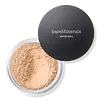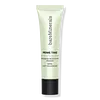What's inside
What's inside
 Key Ingredients
Key Ingredients

 Benefits
Benefits

 Concerns
Concerns

 Ingredients Side-by-side
Ingredients Side-by-side

Water
Skin ConditioningDecyl Cocoate
EmollientCoco-Caprylate/Caprate
EmollientCaprylic/Capric Triglyceride
MaskingTriheptanoin
Skin ConditioningKaolin
AbrasivePropanediol
SolventAvena Sativa Kernel Oil
Skin ConditioningCetearyl Olivate
Cellulose
AbsorbentOleyl Erucate
EmollientSqualane
EmollientSorbitan Olivate
EmulsifyingC9-12 Alkane
SolventDilinoleic Acid/Butanediol Copolymer
Chamomilla Recutita Flower Extract
MaskingHelianthus Annuus Seed Oil
EmollientTocopherol
AntioxidantBisabolol
MaskingSalicyloyl Phytosphingosine
Skin ConditioningPentaerythrityl Tetra-Di-T-Butyl Hydroxyhydrocinnamate
AntioxidantSulfur
AntiseborrhoeicHydrogenated Palm Glycerides Citrate
EmollientZinc Ricinoleate
Magnesium Aluminum Silicate
AbsorbentCetearyl Alcohol
EmollientCetyl Palmitate
EmollientGlycerin
HumectantSorbitan Palmitate
EmulsifyingEthylene/Propylene/Styrene Copolymer
Xanthan Gum
EmulsifyingSorbitan Oleate
EmulsifyingCastor Oil/Ipdi Copolymer
Acacia Senegal Gum
MaskingMica
Cosmetic ColorantButylene/Ethylene/Styrene Copolymer
Phenoxyethanol
PreservativeCI 77163
Cosmetic ColorantCI 77289
Cosmetic ColorantCI 77288
Cosmetic ColorantZinc Oxide
Cosmetic ColorantWater, Decyl Cocoate, Coco-Caprylate/Caprate, Caprylic/Capric Triglyceride, Triheptanoin, Kaolin, Propanediol, Avena Sativa Kernel Oil, Cetearyl Olivate, Cellulose, Oleyl Erucate, Squalane, Sorbitan Olivate, C9-12 Alkane, Dilinoleic Acid/Butanediol Copolymer, Chamomilla Recutita Flower Extract, Helianthus Annuus Seed Oil, Tocopherol, Bisabolol, Salicyloyl Phytosphingosine, Pentaerythrityl Tetra-Di-T-Butyl Hydroxyhydrocinnamate, Sulfur, Hydrogenated Palm Glycerides Citrate, Zinc Ricinoleate, Magnesium Aluminum Silicate, Cetearyl Alcohol, Cetyl Palmitate, Glycerin, Sorbitan Palmitate, Ethylene/Propylene/Styrene Copolymer, Xanthan Gum, Sorbitan Oleate, Castor Oil/Ipdi Copolymer, Acacia Senegal Gum, Mica, Butylene/Ethylene/Styrene Copolymer, Phenoxyethanol, CI 77163, CI 77289, CI 77288, Zinc Oxide
 Reviews
Reviews

Alternatives
Ingredients Explained
These ingredients are found in both products.
Ingredients higher up in an ingredient list are typically present in a larger amount.
This synthetic powder is used to add a pearly/white color in cosmetics.
Mica is a naturally occurring mineral used to add shimmer and color in cosmetics. It can also help improve the texture of a product or give it an opaque, white/silver color.
Serecite is the name for very fine but ragged grains of mica.
This ingredient is often coated with metal oxides like titanium dioxide. Trace amounts of heavy metals may be found in mica, but these metals are not harmful in our personal products.
Mica has been used since prehistoric times throughout the world. Ancient Egyptian, Indian, Greek, Roman, Aztec, and Chinese civilizations have used mica.
Learn more about MicaZinc Oxide is a mineral broad-spectrum UV filter; it is the broadest UVA and UVB reflector approved by the FDA. It also has skin protectant and skin soothing properties.
Zinc oxide is one of the most effective broad-spectrum UV filters. It protects against UVB, UVAII, and UVAI. In comparison to its counterpart titanium dioxide, zinc oxide provides uniform and extended UVA protection.
Another great benefit? This ingredient is highly photostable so it won't degrade easily under sunlight.
A common myth is that mineral UV filters are widely believed to primarily reflect UV light.
However, modern research shows titanium dioxide absorbs UV radiation like chemical filters (~95% absorption & 5% reflection).
Zinc oxide has great skin soothing properties so you'll likely find this in sunscreens formulated for sensitive skin or babies/children. It is unlikely to cause "eye sting" like other sunscreen ingredients.
Regulatory agencies consider zinc oxide to be non-toxic and safe. It has also been shown to not penetrate the skin.
Unfortunately, this ingredient does leave a visible white cast. This is why mineral sunscreens are often less cosmetically elegant than chemical or hybrid ones.
In cosmetics, zinc oxide can be found in both non-nano and nano-sized forms. The nano version is used to reduce white cast and improve the texture of sunscreen formulas.
There are ongoing concerns surrounding nano-zinc oxide's impact on marine ecosystems and whether it can be absorbed into skin.
Regarding marine ecosystems and coral reefs, there is no conclusive evidence that any form of zinc oxide (or any other sunscreen ingredients) will cause harm. The science is still developing but many consumers are keeping a close eye on this issue.
Please note, many destinations have reef-safety sunscreen rules. For instance, the U.S. Virgin Islands advises all visitors to use non-nano mineral sunscreens.
There has also been some stir about whether micronized or nano zinc oxide has potential photoxicity and absorption through the skin/lungs.
An in-vitro (done in a test tube or petri dish) study demonstrated micronized zinc oxide to have potential phototoxicity. There's no need to fret; the EU Commission's Scientific Committee on Consumer Safety has stated, "The relevance of these findings needs to be clarified by appropriate investigations in vivo." Or in other words, further studies done on living organisms are needed to prove this.
Current research shows zinc oxide nanoparticles do not penetrate intact or sunburned skin. They either remain on the surface or in the outermost layer of dead skin (stratum corneum).
Zinc oxide is one of only two classified mineral UV filters with titanium dioxide being the other one.
Fun fact: Zinc has been used throughout history as an ingredient in paint and medicine. An Indian text from 500BC is believed to list zinc oxide as a salve for open wound. The Ancient Greek physician Dioscorides has also mentioned the use of zinc as an ointment in 1AD.
Learn more about Zinc Oxide